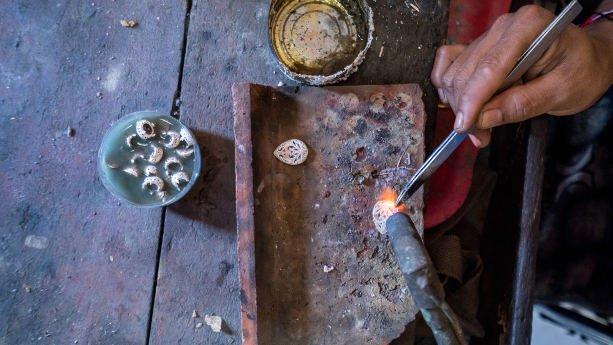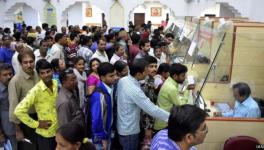Artisans Turn into Vegetable Vendors, Hawkers as Gold Industry Loses Glare

The pandemic has suddenly changed the professional identity of several migrant jewellery artisans. Finding it difficult to sustain the onslaught of Covid on the gold jewellery business of the MSME sector, several such artisans have left Mumbai and other cities of Maharashtra for their native places in West Bengal, where their new identities are vegetable vendors, rickshaw pullers and Toto drivers and hawkers. These artisans were earning a livelihood mainly by working on a piece-rate basis.
Small and medium-scale jewellery units, which comprise around 60 per cent of the estimated five lakh jewellery units in the country, took the maximum hit during the two-phase pandemic.
Kalidas Sinha Roy, Mumbai-based chairman of the Indian Goldsmith Federation (IGF), told Newsclick that an estimated 45 per cent of nearly 1.5 lakh artisans were forced to call it a day due to the high cost of living in Mumbai and even second-rank cities of Maharashtra. The artisans had no choice but to start afresh in their native places in Hooghly, Howrah, Purba and Paschim Medinipur and a few other districts of West Bengal.
“There is no guarantee that business prospects will look up any time soon. After the first phase of Covid-19, many artisans came back. But the devastating second phase and the fear of a third wave hit their moral,” Sinha Roy added.
In Gujarat too, the Bengal-speaking artisans have left Ahmedabad and other centres of jewellery business, like Bhuj, Anand, Nadiad, Baroda, Rajkot and Surat.
In Ahmedabad, big jewellery businesses are buying out small units, according to Rauf Shaikh, president of Ahmedabad-based Samasta Bangali Samaj Association. The big, affluent outfits are also targeting units who undertake outsourced jobs with the assurance of regular and higher income. The Bengali-speaking artisans in Gujarat numbered nearly one lakh, but several of them have gone back to West Bengal in the last one-and-a-half years.
According to Jainal Abedin of the Guwahati-based Nikhil Assam Swarna Silpi Samity, inroads made by Kolkata-based wholesalers and established jewellery houses have dented the locally made jewellery businesses. “Though the craze for gold jewellery remains, there is increasing preference for Kolkata-manufactured necklaces, chains, bangles and rings.”
Till the mid-1990s in Assam, nearly 2.5 lakh artisans were engaged in different aspects of this composite and complex job, which involves designing, moulding, casting, polishing and embellishing. The number has shrunk to one lakh after the business volume started shrinking. Most of the other 1.5 lakh artisans took up agriculture and allied activities, Abedin added.
The situation in south India is not that bad due to the traditional craze for gold jewellery. Sushil Mondol, president of Bengaluru-based Bengali Swarnashilpi Association, told said that “by and large we are able to carry on despite some decline in volume caused by Covid”. Some artisans have left for their native places, “but there has been no disruptive impact on our business”, he added.
General secretary of Hyderabad-based Bengali Goldsmith Association, Mahitosh Jana, sounded a little more optimistic than Mondol. “The footfall and transactions are visible. The high gold price may have been a restraining factor, but the attraction for gold jewellery very much remains. We are looking forward to forthcoming Ganesh Puja,” he told Newsclick.
Amid the declining business and fears of a third Covid wave, the mandatory hallmarking, implemented on June 16, has become a cause of concern for jewellers. Jewellers have formally welcomed the decision—as it “assures the purity and fineness of gold to the consumer”—but they find the Bureau of Indian Standards (BIS) guidelines very stiff.
The economic slowdown and the BIS guidelines have united the MSME sector jewellers associations like the IGF, which was formed around two years back and has about 70 regional associations under its fold. They filed a writ petition before the implementation of the mandatory hallmarking at the Nagpur Bench of the Bombay High Court.
The BIS has allowed jewellers time till August 31 to adjust to the new regime. If a jeweller is found selling gold jewellery without the BIS hallmark, the proprietor could be penalised five times the price of the product or could even face imprisonment of up to one year.
One of the main grievances of the associations with the department of consumer affairs is that the BIS took the decision by only discussing the dos and don’ts with the associations of large jewellery houses.
General secretary of Kolkata-based Bangiya Swarnashilpi Samity and New Delhi-based Akhil Bharatiya Swarnkar Sangh, Tagar Poddar, said that the BIS is not ready to accept ornaments in small lots, say, three, four or five pieces. “It is ridiculous to expect the MSME sector jewellers to submit a large lot of ornaments in one go. If they could, they will lose their MSME status,” Poddar told Newsclick.
Besides, it is not possible to get the stock-in-trade hallmarked given the inadequacy of hallmarking centres. The writ petition stated that the number of hallmarking centres is just 34 per cent of the requirement and, at least, 488 districts do not have centres. “There are about 6,000 crore pieces of jewellery which need to be hallmarked,” the petition stated.
Get the latest reports & analysis with people's perspective on Protests, movements & deep analytical videos, discussions of the current affairs in your Telegram app. Subscribe to NewsClick's Telegram channel & get Real-Time updates on stories, as they get published on our website.
























